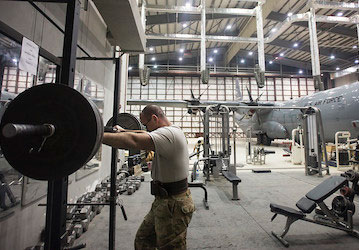High levels of physical fitness are required to do well on your physical fitness test (PFT). But being physically strong can only take you so far. Strong mental-fitness strategies are vital to help you max the test and get closer to optimal performance.
Goal setting for fitness training
The first step to leveraging mental fitness to optimize physical fitness is to set SMART goals. Setting specific goals will help you define an end point, rather than “get better” goals. For physical fitness, it works well to set a long-term goal that’s about 6 months out and more short-term goals with milestones that you can check off along the way. Coupled with a progressive workout program, this plan will help you get fit and perform well on your fitness test.
You can also set yourself up for success by using “when…then” statements or “implementation intentions.” You might think, “WHEN (obstacle or opportunity), THEN I will (effective plan).” “When…then” statements help you make your workout plan automatic. For example, if you’re struggling to decide whether to work out in the morning, after work, or after dinner each day, you could make a plan: “WHEN I come home from work, THEN I’ll immediately change into my running clothes and go for a run.”
Mindfulness
The PFT is a common source of anxiety for many Military Service Members because it’s tied to your career outcomes. Will you do well enough to stay in your career field? Did your poor performance on your last PFT hurt your promotion status? These thoughts are common and normal. Still, they can affect both your physical training and how well you perform on test day. It’s very much like people who are poor written-test takers. They know the book inside and out, but can’t do well on a test to save their life. So even if you’re physically ready to take your PFT, anxiety about the test can impact your performance as well.
Mindfulness is a valuable skill for physical training and for when you take your test. It’s the practice of training your brain to stay in the present moment, so you aren’t reliving the past or worried about the future.
While you’re working out in the gym, mindfulness can help keep you focused too. The stressors of life can interfere with your workout, especially if you’re hanging on to a rough morning before, or stressing about something coming up soon. If you’re distracted, it will be harder to get a good workout in and make progress towards your goals. Thinking about the workout itself can help, and be sure to focus on your breathing. Is the weight you’re using challenging—but not too heavy—that you can’t do the lift properly? Which key techniques are important to focus on, so you can ensure a safe lift? Keeping your mind on the present will help you get the most out of your workout and let you start to feel the stress-relief aspects of regular exercise.
During the test, mindfulness is like setting short-term SMART goals. For example, if your PFT consists of push-ups, sit-ups, and a run, break it down to each component. While you’re doing your push-ups or sit-ups, focus on the exercise: “Keep my back straight. Breathe in, push, breathe out. One more rep. One more rep.” Thinking about the next component can distract you from the one that you’re testing and hurt your performance. If the next component is your worst, that doesn’t matter right now because you’re working on doing your best at this moment. Then when you get to your worst component, try focusing on the next rep—or the next step—to carry you through the event and bring you out of it having done well.
Self-talk
Self-talk is what you say to yourself as you interpret and review the different situations you face during the day. In short, it’s your thoughts to yourself. Negative self-talk can bring you down and dramatically hurt your performance. On the other hand, positive self-talk can help you embrace the suck of the workout (or PFT) and come out on top. To practice positive self-talk, use HPRC’s worksheet to identify unhelpful thoughts and ways to challenge them to optimize your physical performance.
In general, there are two types of positive self-talk: motivational and instructional. Motivational self-talk is when you tell yourself to remember to breathe. In addition, you might repeat your mantra or say, “I’ve trained hard for this event for the past 6 months.” Motivational self-talk can be extremely helpful during endurance events such as your PFT. It helps decrease “ratings of perceived exertion” (RPE) or your feelings about a task’s difficulty. The lower your RPE, the easier you feel the task is. If you perceive a task to be easier, you’ll be able to work at a higher level of intensity to go faster, perform more reps, or generally do better at the task.
Instructional self-talk is when you talk yourself through the step-by-step process of a task. This can be helpful for multi-stage PFT events like the ACFT’s sprint-drag-carry event. Or you can use it when breaking down a power clean or other complex lifts.
Physical fitness training is a complex task that’s more than just lifting and running. Understanding the mental component of physical fitness can help you perform better and get closer to your goal of optimal human performance.
